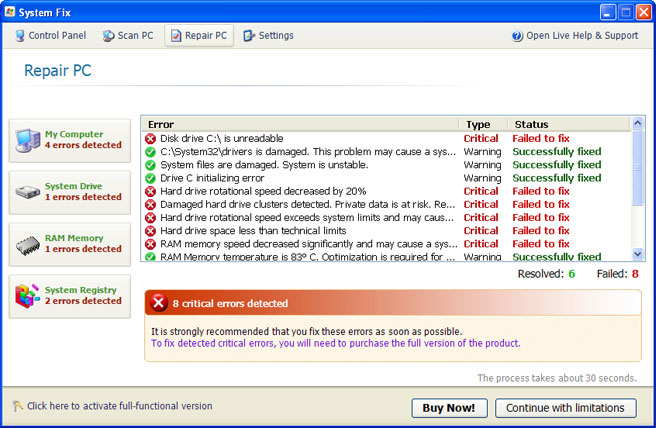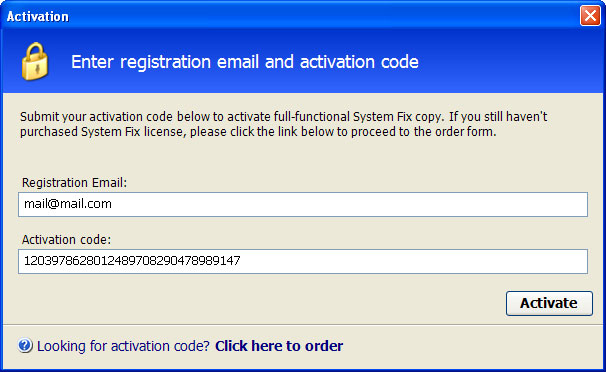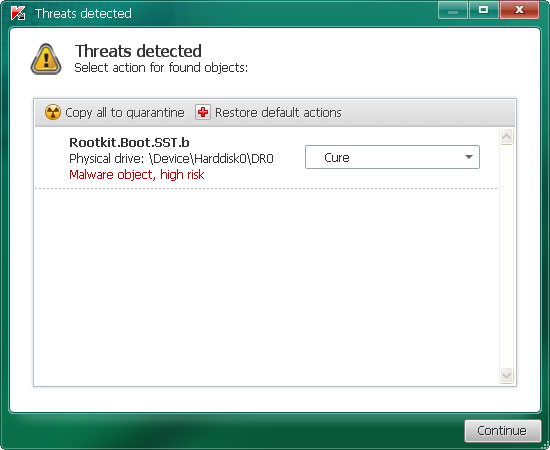Don't Copy From This Blog...
System Fix is a type of malware commonly known as rogueware that attempts to steal money from victims by luring them into paying to fix nonexistent system errors and threats. If you think that it does have some rudimentary PC repair software functionality then you are wrong. With such a generic name and Microsoft trademarks, System Fix tries to pass off as a legitimate computer repair program. However, it's nothing more but a scam. Rogue programs are considered one of the most prevalent and dangerous threats lurking on the Web today. The goal of cyber crooks is to profit from malicious software. Infected computer are widely used for malicious criminal activities such as spamming and distributing malware.If this fake PC repair program took over your computer, there's a great chance it also installed more sophisticated malware, very often TDL3/4 rootkit or Rootkit.Boot.SST, to avoid antivirus detection and to block malware removal tools. Most rogues don't show suspicious behaviors, so antivirus companies have to focus on signatures. In a previous writeup, we examined how to remove a rogue program called Data Recovery. System Fix is from the same family of malware and it hasn't been updated recently. It's just another name, but the infection is 100% the same. We'll show you how to rid of it or at least disabled it long enough to remove it. To remove System Fix malware from your computer, please follow the removal instructions below.

Rogues share a number of commonalities:
- blocks legitimate anti-malware software
- displays fake hard drive pre-failure warnings and notifications
- mimics genuine products
- complete system scan is super fast and completely false
- it proceeded to pretend to fix the critical problems it claimed to have found on a brand-new
- installation of Windows
- hides Windows icons and shortcuts to make you think that your hard drive is going to fail


Most rogue programs go beyond aggressive marketing to sell software that has no functionality. System Fix is a good example of such misleading software. Users, naturally worried about the supposed critical system error, will often buy the license. Don't blame yourself if you fell for this scam. Cyber crooks adopted scareware on a massive scale and about 2-3% of victims will probably buy it. Instead of blaming yourself, call your credit card company and dispute the charges. Or even better, cancel your credit card and create a new one. Cyber cooks may use stolen credit card details again. Last, but not least, install solid antivirus software and keep it up to date. And next time, do a research before paying for software you didn't go looking for it. Good luck and be safe online!
Before continuing with the removal instructions, you can use cracked registration key and fake email to register System Fix. This will allow you to download and run any malware removal tool you like and restore hidden files and shortcuts.
mail@mail.com
15801587234612645205224631045976 (new code!)
mail@mail.com
1203978628012489708290478989147 (old code, may not work anymore)

Download recommended anti-malware software (direct download) and run a full system scan to remove this virus from your computer.
http://spywareremovalx.blogspot.com
Important! First of all, please follow the removal instructions outlined on this page. Full write-up and manual removal guide can be found here: http://spywareremovalx.blogspot.com/2011/09/how-to-remove-data-recovery-uninstall.html (works with System Fix malware too). Follow it in case the removal guide below didn't work out. Good luck!
System Fix removal instructions:
1. Open Internet Explorer. If the shortcut is hidden, pelase Select Run... from the Start Menu or just hit the key combination CTRL+R on your keyboard. In the Open: field, enter iexplore.exe and hit Enter or click OK.

2. Download and run this utility to restore missing icons and shortcuts.
3. Now, please download TDSSKiller and run a system scan. Remove found rootkits as shown in the image below. Reboot your computer if required.

Please note that your computer might be rootkit free, not all version of System Fix comes bundled with rootkits. Don't worry if TDSSKiller didn't find a rootkit.
4. Finally, recommended anti-malware software (direct download) and run a full system scan to remove this virus from your computer.
NOTE: With all of these tools, if running Windows 7 or Vista they MUST be run as administrator. Launch the program and follow the prompts. Don't forget to update the installed program before scanning.
5. The virus should be gone. If certain icons and shortcuts are still missing, please use restoresm.zip.
Share this information with your friends:

















0 comments:
Post a Comment